The Hilgartner Stone Company: Over 150 Years of Stonework in Style
Joel Davis
Photos by Geoff Graham
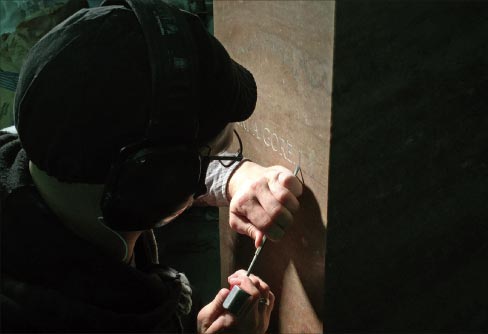 |
|
Hilgartner marble mason hand-carves the names and terms of office on Tennessee marble bases for busts of Vice Presidents of the United States, at the U.S. Capitol Building. |
Despite more than a century of service, Hilgartner Natural Stone Company Inc. prides itself on agility in a changing market.
Based in Baltimore, the 153-year-old company has weathered large shifts in the stone industry. This has led it to a focus on restoration, repair, and historic replication. “We take our capabilities and try to apply them where they are most in demand,” President Tom Doyle said.
Hilgartner completes between 150 and 200 jobs each year. This is split fairly evenly into work for institutions such as colleges, churches or the government, commercial projects, and residential jobs. On a regular basis, it employs 15 people but will bring more on as needed.
Hilgartner recently completed the restoration of the Centre Theatre, an iconic Baltimore structure from the early 1900s, worked on restoring the Battle Acre Memorial and restored a downtown plaza facility for the City of York, Pennsylvania.
The company fabricated a base for a bronze bust of Winston Churchill that was installed in the small House Rotunda on the first floor of the U.S. Capitol in 2013. The company also fabricated two bases for busts of vice presidents for the Architect of the Capitol.
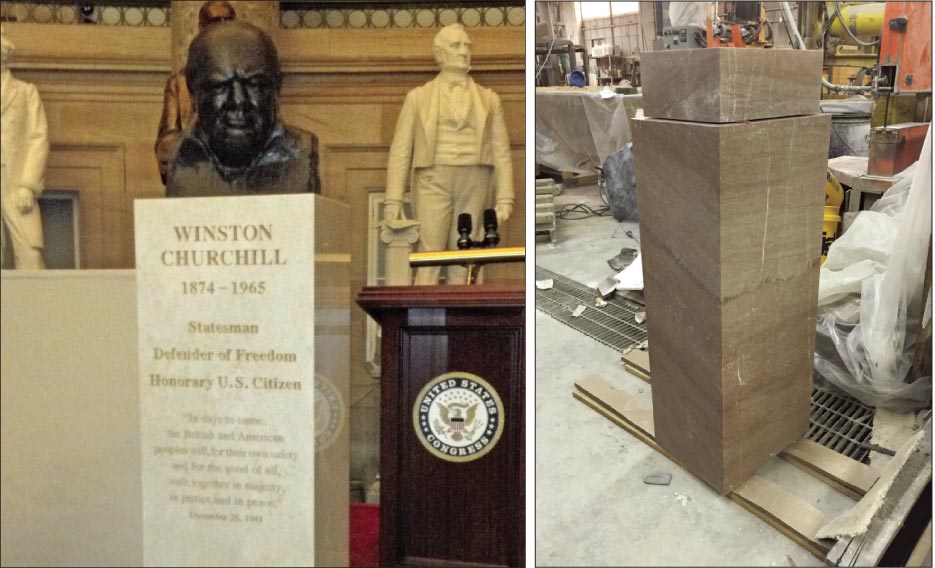 |
|
Above, Left: The bust of Churchill, installed in a prominent location at the U.S. Capitol Building, in 2013. Sourcing historic and difficult-to-find stone for replication, repair and restoration is an area where Hilgartner Stone Company excels. Above, right: Square column of Tennessee Rose marble, a stone that was used extensively throughout government buildings and public spaces in Washington D.C. . |
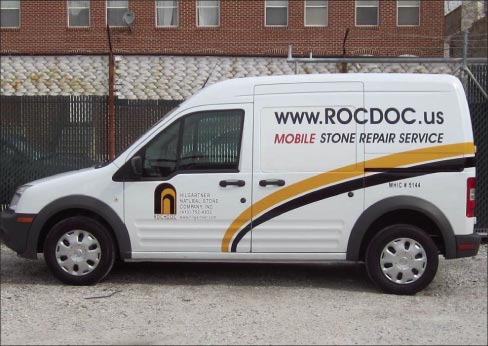 |
|
Above: The RocDoc van is fully outfitted to repair and restore stone. Unlike modern M.D.s, it does make house calls. |
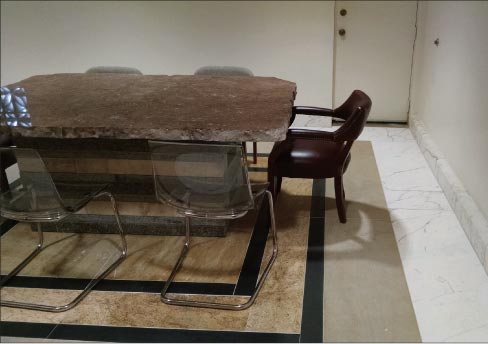 |
|
Above: The Hilgartner Severn Street headquarters is also a showcase for an award-winning project. Flooring of the conference room, handicapped bathroom and lobby uses fully repurposed materials – uninstalled at other buildings and re-installed as mud-set floors, with varying thicknesses, types of material and varying finishes. |
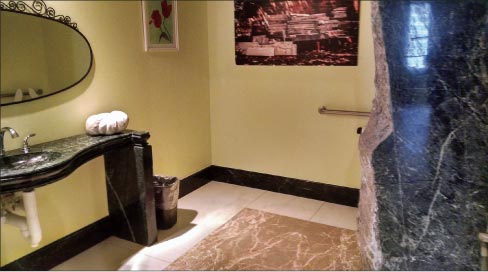 |
|
Above: The Hilgartner headquarters in Baltimore has a custom, handicapped bathroom that also showcases their expert and tasteful handling of repurposed stone materials. |
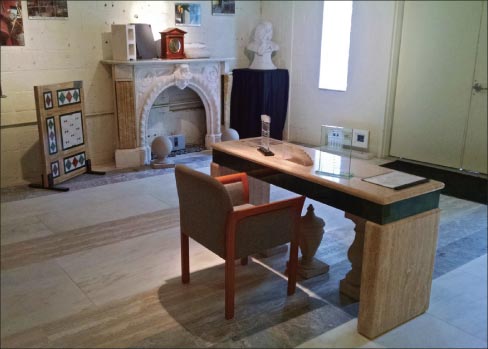 |
|
Above: Hilgartner’s work on its new facilities received the #1 ranking for all projects of any trade evaluated for the 2016 BCE awards. |
Hilgartner restored St. Patrick’s Roman Catholic Church in Baltimore. It is now working on multiple items for the St. Patrick’s Cathedral in New York City. This is the final step of a five-year restoration.
The company also built a new marble base for the elephant at the entry to the Smithsonian Museum of Natural History. It installed the base without moving the elephant, a pretty remarkable feat of engineering, in itself.
The residential market for stone shifted dramatically with the advent of automated lines to produce granite countertops, Doyle said. “There has been great downward pressure on the price over the last 25 years.”
This automation has proven lucrative for a lot of companies. It has also proven to be the downfall of many, Doyle said. “We made the conscious decision in the 1990s to not automate. A lot of people made an awful lot of money from automated fabrication facilities, but they weren’t in the type of position to survive the situation we saw back in 2008. You can only make one thing and nobody is buying it. By going with skilled craftsmen, we were able to shift over to the restoration side of things. People are able to change. Automated equipment can’t.”
Stone restoration has become a major emphasis for the company. “That’s really a function of looking at what is happening in the market,” Doyle said. “More stone was installed between 1990 and 2010 than probably was installed in the previous 60 years. You also have the stone that was installed in the 1900s that has now had some time to be out there, get weathered, get beat up on, but is not ready to get knocked down.”
The restoration and repair market can only grow. “It’s not abnormal now for a $200,000 house to have granite kitchens and marble bathrooms,” he said, adding that used to be confined to expensive homes. “With 20 years of stone going into those environments, there is an awful lot of stuff out there that needs a little bit of fixing.”
One of the ways that Hilgartner has responded to this need is to take its services on the road. It markets its Roc Doc service. The mobile van is fully outfitted with materials and equipment to repair and restore stone. It makes house calls to customers needing a little TLC for their stone.
This could be a chipped countertop, broken floor tile, or a damaged conference table in an office. “We send the Roc Doc around very much like a plumber,” Doyle said.
The Roc Doc gives customers control of the situation. “They are the ones that are there determining how long the man works on it,” Doyle said. “If they want to pay to have him go the extra mile, they can.”
On the commercial side, in recent years, Hilgartner worked on the Ivy Hotel, Baltimore’s first true five star hotel. Hilgartner received two craftsmanship awards, issued by the Building Congress & Exchange, for marble work this year. One award was for work at a new hospice in Baltimore County. The other was for the work Hilgartner did on its own lobby.
The highest rated of the projects is a very special floor installation. “It has some very odd angles and different material intermixed,” Doyle said. “It was a historically installed floor –a mud set and a honed finish– mixing sandstone, granite, limestone and marble. All salvage. All removed from different buildings.”
The company moved into its new facility at 2220 Severn Street in Baltimore in late 2015. The 16,000-square-foot former foundry provides an open and flexible space for the company.
“The most critical aspect of the design is significant slant towards fundamental flexibility,” Doyle said.
The facility includes overhead crane coverage of 50 percent of the entire workspace. There is full floor drainage of 50 percent of the workspace. There are four overhead door access points. Compressed air service is available in 60 percent of the workspace. All heavy equipment is surface mounted.
“These items combine to allow us to change from a marble shop to a granite shop, from a production shop to a historic restoration facility or from a fabrication facility to a carving facility literally over a long weekend,” Doyle said. “We’ve got the flexibility to change the nature of the work we perform.”
The production side of the facility includes 5,000 square feet of space for a wet shop and about 3,000 square feet for stone carving. The facility includes a 1,500-square-foot showroom.
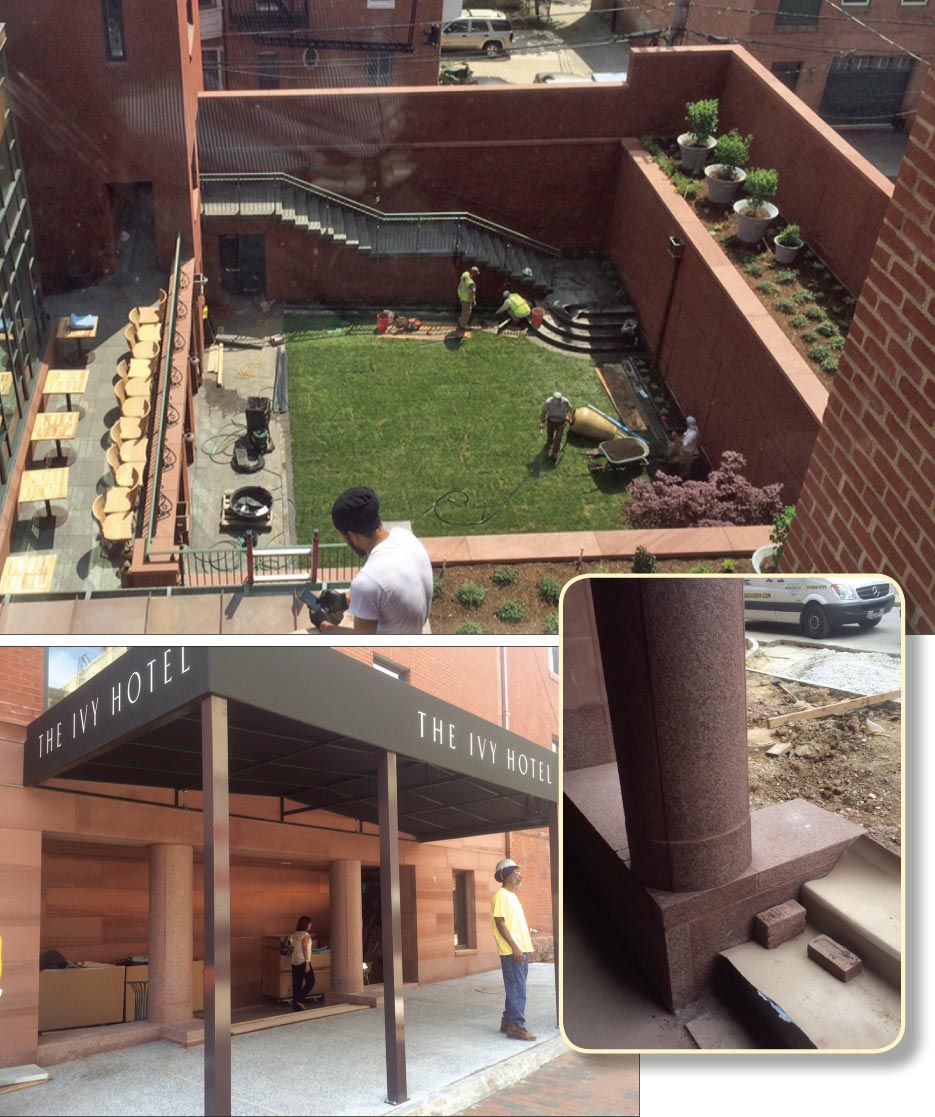 |
|
Work in progress on the Ivy Hotel, Baltimore’s only five-star hotel. New construction and repair in the hotel courtyard included work to steps, column masonry, patio deck steps leading to the interior, and stone fireplaces throughout. Tom Doyle commented, “Hilgartner has the only accredited marble shop-finisher apprentice program in the USA – the equivalent to a Cabinetmaker in wood. We are trying to keep these skills alive.” |
Creating a facility that was easily reconfigurable was important, Doyle said. “The reason for this is a fundamental belief on the part of management that the business battle is not won by the biggest, or wealthiest – but rather the most nimble. Those organizations who not only identify the changes in market needs, but can respond quickly to meet those needs.”
It’s not just the new facility that makes the company agile. “This nimbleness needs to have a mindset, as well as a facility,” he said. “We clearly now have the facility –and a large part of my job is to make certain that the entire organization maintains the mindset to go along with it.”
Nimble is probably not a word applied to many companies more than a century-and-a-half old. Hilgartner Natural Stone Company was founded by Ludwig Hilgartner, who immigrated to the United States to pursue a career in stone cutting.
Doyle came on the scene in 1986. He bought the company after returning home to Baltimore. He had previously worked for Eastman Kodak.
Although he had no previous stone industry experience, Doyle found himself in the perfect place to learn.
“I had a company that had at that point the only remaining apprenticeship program in the country,” he said. “I had the shop foreman available to teach me the operations within the shop. We were the last surviving union installer in the state of Maryland. I learned about traditional installation methods. I was able to get a crash course on the industry as a whole.”
Doyle said he also had the benefit of learning from John F. Hardtke Jr. A member of the Hilgartner staff, Hardtke became president of the Marble Institute of America in 1987.
The longevity has brought other advantages. “One of the fringe benefits of being a 153-year-old company is that when times get bad, our phone rings off the hook,” he said. “There is a real flight to safety in this line of work. Contractors want to take a quote from someone they are sure will be in business.”
This became evident during the last period of economic uncertainty. “When the markets shrank dramatically in 2008, we were getting a call on virtually every job in Maryland,” Doyle said. “There weren’t that many of them, but we were getting a call on all of them. Over the 30 years I’ve been here, our best years have been recessionary years and some of our worst years have been expansion years for the industry as a whole.”
Doyle gives credit to the skill of his employees for the success of the company. The trained workforce provides great advantages.
“We do the fabrication and do the installation,” he said. “All of the work from beginning to end is done with our own staff, which really is somewhat unique within the stone industry. It’s not pulling together a pile of different subcontractors.
“When we do take a look at a larger commercial job having the shop gives us the flexibility to take advantage of importing a job cut to size while still having the ability to alter and change things immediately as they are needed.”
In the commercial arena, flexibility is important as well, Doyle said. “In the design of office buildings and even churches, it’s at the last moment they’ll make their final decision, and you really don’t have the time to get something made elsewhere,” he said. “With us having the ability to ensure the very last items are correct, while at the same time offering the ability to bring it in from overseas, that gives us some unique flexibility that our competitors don’t have.”
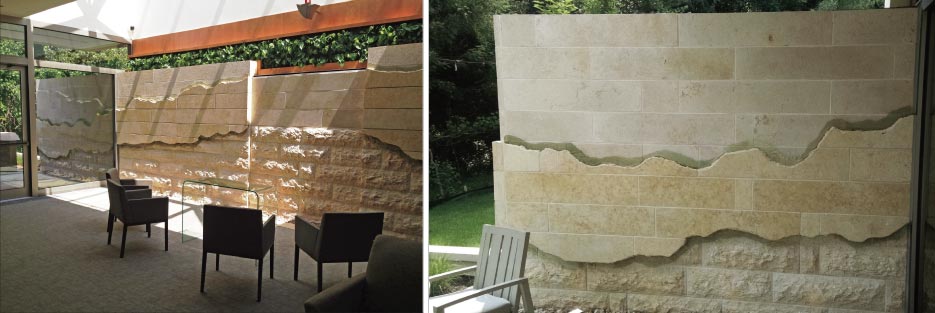 |
|
Serenity contemplation wall at the Gilchrist Hospice Center, in Towson, Maryland, uses several varieties of Jerusalem stone, prized for its warm, honey-brown color. The Serenity Wall incorporates a stone fountain and extends through a glass wall, continuing the pattern. Hilgartner imported this stone especially for this project, and processed, chiseled and fabricated in their own factory. |
Hilgartner ensures its customers are satisfied with its work. “Customer satisfaction – that is really a driving force here,” Doyle said. “The only dissatisfied customer is a surprised one.”
Educating the customer starts on the front end and ends in the field. “The field guys or installers are instructed that their job is to make these people happy,” he said. “By that time, they’ve already had feedback from sales people, the feedback from drafting, and their expectation is set. At the installation side, they can turn a regular generally satisfied customer into a truly happy one by giving just a little bit extra.”
Shop operations at Hilgartner combine the best of the new and old. For example, in addition to newer Park Industries equipment, the shop still uses a Tysaman polisher and a saw from the 1950s.
“I emphasize to our shop foreman to always keep yourself exposed to the new things that come up in the marketplace,” Doyle said.
The new, however, doesn’t trump proven techniques. “Frankly, when we get one dip in quality, the shop foreman makes them pick up the white stones and hone stones … and go back to rubbing things until they come out straight,” Doyle said. “You can try to do that with a grinding tool. What is far better is to pick up a 180 grit stone and rub it against the edge.”
The company does not rely on word-of-mouth alone. “A whole lot of people know about Hilgartner, but there is an entire generation that if they can’t find it on Google, they’re not calling it,” Doyle said.
The new facility allows Hilgartner to better support its online efforts with bricks-and-mortar. “We do have an interactive retail site where transactions can occur and things can be bought and sold,” Doyle said. “We sell a full line of stone maintenance products and our new facility has a nicely inventoried shipping office. When those orders come in off of the internet, we are able to fill them painlessly. That is part of bringing the old and the new together.”
Balancing the strengths of classic techniques and the newest technology is the secret to satisfied customers.
“The newer techniques do things faster, therefore they do them cheaper,” Doyle said. “If you know both, you know when you’re sacrificing quality for that speed. You have to know that you’re making the trade-off. You’ve got to be able to recognize it; then you’re able to satisfy the customers. As long as you keep the customer apprised of his choices and his expectations are being delivered to him, that’s going to be a satisfied customer.”